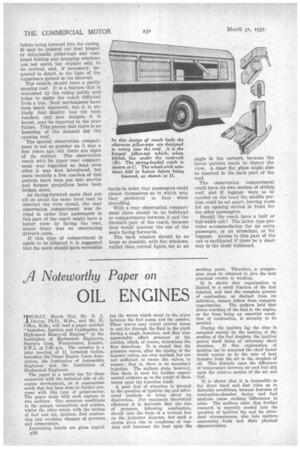11 Noteworthy Paper on
Page 50

If you've noticed an error in this article please click here to report it so we can fix it.
OIL ENGINES
TO-DAY, March 31st, Mr. S. .T. Davies, Ph.D., M.Sc., and Mr. E. Giffen, M.Sc., will read a paper entitled "Injection, Ignition and Combustion in High-speed Heavy-oil Engines" at the Institution of Mechanical Engineers, Storey's Gate, Westminster, London, S.W.I, at 7.45 p.m. The occasion is a joint meeting of II technical bodies, including the Diesel Engine TJsers Association, the Institution of Automobile Engineers and the Institution of Mechanical Engineers.
The paper is a useful one for those concerned with the technical side of oilengine development, as it summarizes mach that has been done to further progress with this type of prime-mover. The paper deals with such engines in two sections. One concerns conditions in the pumps, connections and nozzles, whilst the other treats with the mixing of fuel and air, ignition, fuel combustion and resulting changes of pressure and temperature.
Interesting details are given regardc28 ing the waves which occur in the pipes between the fuel pump, and the nozzles. These waves may travel several time to and fro through the fluid in the pipek during a single injection, and they may appreciably affect pressure at the nozzles, which, of course, determines the flow therefrom. It is stated that the pressure waves, after the closing of the injector valves, are very marked, but are not sufficient to cause the valves to reopen ; that is, there is no secondary injection. The authors state, however, that there is need for further experimental evidence as to the result of these waves upon the injection itself.
A good deal of attention is devoted to the question of ignition lag and advocated methods to bring about its diminution. For maximum theoretical efficiency it is desirable that the rise of pressure, following combustion, should take the form of a vertical line on the indicator diagram, but such a course gives rise to roughness of running and increases the load upon the working parts. Therefore, a compromise must be obtained to give the best practical results in working.
It is shown that vaporization is limited to a small fraction of the fuel injected, and that the complete process of combustion, as distinct from its initiation, cannot follow from complete
vaporization. The authors hold that direct cracking of the fuel in the engine, so far from 'being an essential condition of combustion, is actually to be avoided.
During the ignition lag the time is occupied mainly by the heating of the surface of the fuel droplets, the ignition period itself being of extremely short duration. If this explanation of ignition lag be accepted the chief factor would appear to be the rate of heat transfer from the air to the droplets of oil. This depends upon the difference of temperature between air and fuel and upon the relative motion of the air and fuel.
It is shown that it is impossible to lay down hard and fast rules as to desirable conditions, because features of combustion-chamber design and fuel analysis cause striking 'differences to arise. The authors state that further research is urgently needed into the question of ignition lag and its attendant circumstances, also into matters concerning fuels and their physical characteristics.












































































































